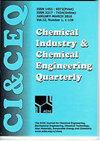Heat transfer studies in a plate heat exchanger using Fe2O3-water-engine oil nanofluid
IF 0.8
4区 工程技术
Q4 CHEMISTRY, APPLIED
Chemical Industry & Chemical Engineering Quarterly
Pub Date : 2022-01-01
DOI:10.2298/ciceq220430029s
引用次数: 1
Abstract
Improving heat transfer performance of conventional fluid creates significant energy savings in process Industries. In this aspect, experimental study was performed to evaluate the heat transfer performance of Fe2O3-Water (W)-Engine Oil (EO) nanofluid at different concentrations and different hot fluid inlet temperatures in a plate heat exchanger. Experiments were conducted by mixing Fe2O3 nanoparticle (45 nm) in a base fluid of water-engine oil mixture with volume fractions of 5%EO + 95%W and 10%EO +90%W. Main aim of the present study is to assess the impact of variations in nanoparticle volume fraction and hot fluid inlet temperature on the heat transfer performance of prepared nanofluid. Based on the experimental results, convective heat transfer coefficient, Reynolds, Prandtl and Nusselt number were determined. Result shows that at the hot fluid inlet temperature of 75?C, the increase in Nusselt number and convective heat transfer co efficient are optimum at 0.9 vol. % nanoparticle for both the base fluid mixtures. The increase in heat transfer coefficient is because of the Brownian motion (increasing thermal conductivity) effect, motion caused by temperature gradient (Thermo-phoretic) and motion due to concentration gradient (Osmophoretic). If the volume fraction of nanoparticle increases then Reynolds number increment is higher than Prandtl number decrement, which augments Nusselt number as well as convective heat transfer coefficient.fe2o3 -水发动机油纳米流体板式换热器的传热研究
改善传统流体的传热性能可在过程工业中节省大量能源。为此,在板式换热器中对Fe2O3-Water (W)-Engine Oil (EO)纳米流体在不同浓度和不同热流体入口温度下的换热性能进行了实验研究。将Fe2O3纳米颗粒(45 nm)掺入体积分数为5%EO + 95%W和10%EO +90%W的水-机油混合基液中进行实验。本研究的主要目的是评估纳米颗粒体积分数和热流体入口温度的变化对制备的纳米流体传热性能的影响。根据实验结果,确定了对流换热系数、雷诺数、普朗特数和努塞尔数。结果表明,在热流体进口温度为75?C,在0.9 vol. %纳米颗粒时,两种基液混合物的努塞尔数和对流换热系数的增加都是最佳的。传热系数的增加是由于布朗运动(增加导热系数)效应、温度梯度引起的运动(热渗透)和浓度梯度引起的运动(渗透)。当纳米颗粒体积分数增大时,雷诺数增量大于普朗特数减量,增大了努塞尔数,增大了对流换热系数。
本文章由计算机程序翻译,如有差异,请以英文原文为准。
求助全文
约1分钟内获得全文
求助全文
来源期刊

Chemical Industry & Chemical Engineering Quarterly
CHEMISTRY, APPLIED-ENGINEERING, CHEMICAL
CiteScore
2.10
自引率
0.00%
发文量
24
审稿时长
3.3 months
期刊介绍:
The Journal invites contributions to the following two main areas:
• Applied Chemistry dealing with the application of basic chemical sciences to industry
• Chemical Engineering dealing with the chemical and biochemical conversion of raw materials into different products as well as the design and operation of plants and equipment.
The Journal welcomes contributions focused on:
Chemical and Biochemical Engineering [...]
Process Systems Engineering[...]
Environmental Chemical and Process Engineering[...]
Materials Synthesis and Processing[...]
Food and Bioproducts Processing[...]
Process Technology[...]
 求助内容:
求助内容: 应助结果提醒方式:
应助结果提醒方式:


